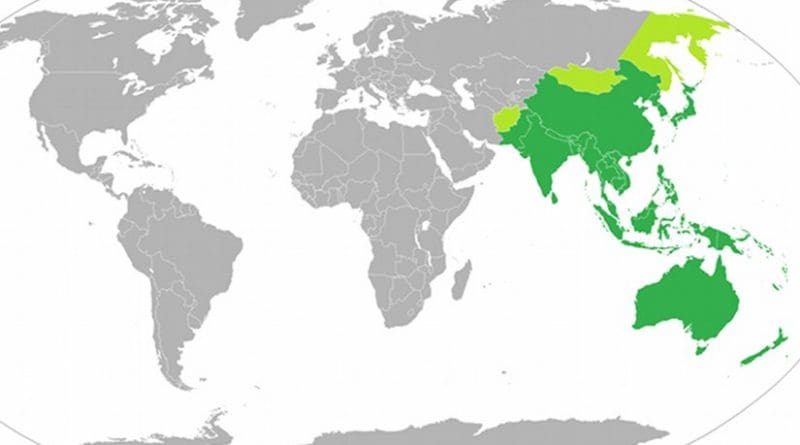Asia-Pacific: Is Middle Power Multilateralism Possible? – OpEd
By IPCS
By Chandrali Sarkar*
In light of President Trump’s abandonment of the original ‘Pivot to Asia’ policy, a recent article in The Indian Express, titled ‘Delhi, Tokyo Canberra’, by C Raja Mohan and Rory Medcalf, has explored possible approaches to counter China’s rise. In the wake of US President Donald Trump’s decision to exit from the Trans-Pacific Partnership (TPP) and the uncertainty that is lurking with President Trump’s intentions in the Asia-Pacific region, the article proposes constructing a middle power coalition among India, Japan and Australia to counterbalance China.
This commentary argues that the feasibility and efficacy of such a proposal seems unlikely at the moment for two reasons: – First, there is the question of whether or not India would want to portray itself as a middle power in this region; and second, the effectiveness of such a coalition vis-à-vis China’s rise is doubtful.
India as a Middle Power
The US’ exit from TPP does not necessarily mean the US’s exit from the Asia-Pacific entirely; however it means greater scope for China to assert itself in the region. Thus the proposal of collaboration among Delhi, Tokyo, and Canberra to restore the balance of power vis-à-vis China automatically raises questions about how India would want to project itself.
Japan and Australia express a clear stand against China. Despite their strong economic ties with China, they condemn the rising threat of China’s aggrandisement in the South China Sea (SCS). Japan’s 2016 Defence White Paper elaborates on this stance. India, unlike the above countries, follows a tricky two-sided diplomacy with respect to China. On one hand India is trying to militarily counterbalance China through its overtures to Japan and Vietnam such as building stronger defense ties, with Japan through the Civil Nuclear Agreement; acknowledging Japan’s permanency in the Malabar joint navel exercise in the Bay of Bengal in 2015; and providing the surface-to-air missile system to Vietnam. On the other hand, India and China share strong bilateral economic relations.
New Delhi and Beijing have strong differences on border issues, relations with Pakistan, and China’s expansionist policy in the Asia- Pacific Region. However, India refrains from using a stern stance against China that Japan and Australia do. India maintains a diplomatic ambiguity towards China.
India may not possess the capabilities of counterbalancing China single-handedly; but like the US, India sees itself as a potential balancer to China’s policies. Thus, it is for India to assess its capabilities and to decide how it wants to project itself; or whether it wants to keep its position ambiguous, if that ambiguity is to its advantage.
Prospective Multilateralism
The second challenge concerns the efficacy of the prospective coalition. This prompts an analysis on the geopolitics of the Asia-Pacific region that plays a significant role in determining the profitability of the middle power coalition. Here, the nations are scattered and most are incapable of unilaterally exerting influence in world politics. Therefore, multilateralism, i.e. a coalition seems, to be the effective solution to ideally balance the scale of power in this region. The authors of ‘Delhi, Tokyo Canberra’ suggest that the trilateral coalition would not do much beyond sending a strong message against China’s rise. This raises questions of how the utility of such a coalition can be improved.
If a middle power coalition is to be attempted, then such an alliance needs the support of other smaller regional powers such a Indonesia, the Philippines and Vietnam – countries that traditionally condemned China for its expansionist policies. This could enable the trilateral configuration to transform into a stronger and more effective multilateral one to fill a power vacuum potentially left by the US in case it chooses to follow a less assertive foreign policy.
At present, the possibility of such an alliance seems very bleak, owing to Indonesia’s and the Philippines’ positions. The Philippines has altered its approximately seven decade old foreign policy stance and is trying to improve its relationship with China by seeking to resolve their SCS dispute. Despite its dispute regarding Natuna Island in the SCS, Indonesia’s strong economic ties with China could deter it from directly posing a strong opposition.
Vietnam and Singapore have demonstrated stronger resistance towards China’s assertions. This is evident in their individual disputes with China in the SCS region and public condemnation of the same. These countries, along with Australia and Japan, could be part of a pragmatic alliance against China; but would this core group be able to effectively balance China without India and the US’ support? And would they be able to rise beyond their economic dependency on China and make a collective move against it? These are some vital questions that need to be examined before coming to conclusions about the effectiveness of a middle power coalition in the Asia-Pacific.
Conclusion
In analysing the plausibility of multilateralism among these middle powers, it can be said that the geopolitical configuration of this region makes group effort an ideal approach. However, such a group effort is not possible owing to these countries’ respective self interests that guide their foreign policies. Under such circumstances, the possibility of a middle power coalition becomes dim.
*Chandrali Sarkar
Research Intern, IPCS
Research Intern, IPCS

